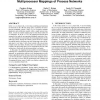Free Online Productivity Tools
i2Speak
i2Symbol
i2OCR
iTex2Img
iWeb2Print
iWeb2Shot
i2Type
iPdf2Split
iPdf2Merge
i2Bopomofo
i2Arabic
i2Style
i2Image
i2PDF
iLatex2Rtf
Sci2ools
CODES
2003
IEEE
2003
IEEE
A multiobjective optimization model for exploring multiprocessor mappings of process networks
In the Sesame framework, we develop a modeling and simulation environment for the efficient design space exploration of heterogeneous embedded systems. Since Sesame recognizes separate application and architecture models within a single system simulation, it needs an explicit mapping step to relate these models for co-simulation. So far in Sesame, the mapping decision has been assumed to be made by an experienced designer, intuitively. However, this assumption is increasingly becoming inappropriate for the following reasons: already the realistic systems are far too complex for making intuitive decisions at an early design stage where the design space is very large. Likely, these systems will even get more complex in the near future. Besides, there exist multiple criteria to consider, like processing times, power consumption and cost of the architecture, which make the decision problem even harder. In this paper, the mapping decision problem is formulated as a multiobjective combinat...
CODES 2003 | Decision Problem | Explicit Mapping Step | Hardware-Software Codesign | Mapping Decisions |
| Added | 04 Jul 2010 |
| Updated | 04 Jul 2010 |
| Type | Conference |
| Year | 2003 |
| Where | CODES |
| Authors | Cagkan Erbas, Selin C. Erbas, Andy D. Pimentel |
Comments (0)

